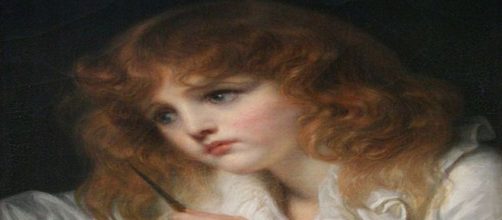If it's true that you shouldn't form an opinion solely by appearance, that goes double for artists and their work. Consider the drawing by 18th-century painter Jean Baptiste Greuze, one of the Old Masters highlighting a Christie's auction sale February 22. The difference between his work and his ways of being might well put him squarely in the gothic novel "Strange Case of Dr. Jekyll and Hyde” except without any bloodletting.
Dual personality
Greuze's work, “La Petite Boudeuse” is a softly-rendered, red chalk drawing of a young girl with an expression of innocent wonder that you might rightly call overly sentimental – something that this artist was not even a little bit like.
Nineteenth-century historian Edmond Jules de Goncourt reported that Greuze was full of self-importance and would fly into “naive” rages at the slightest criticism of his work. When a Mademoiselle Geoffrin called one of his especially saccharine works - La Mere Bien-Aimee - the “fricassee of children,” he screamed that she better be careful, or he'd make her immortal as a “schoolmistress with a whip in her hand who frightens children not only of today but also those as yet unborn.”
His own worst enemy
He wasn't even nice when he got a compliment. De Goncourt cited an incident when a Monsieur de Marigny praised one of his works - La Pleureuse – Greuze said that he was aware of how good it was but that it didn't translate into commissions.
Landscape painter Claude Joseph Vernet explained to him why he doesn't get commissions, saying it's because he has a “swarm of enemies” one of whom is responsible for his ruin – himself. The French philosopher Denis Diderot also offered a reason why people steered clear of him, pointing out the way he treats his wife. “It's like a Punch and Judy show.” All this is hard to reconcile with his super-soft and altogether sugary looking pictures, especially of women.
Two-faced
Of course, Greuze wasn't the only artist with a dual personality - one for his work and one for the world. Sixteenth-century painter Giulio Romano comes to mind. His picture-making might fairly be seen as fierce, even brutal.
In his painting of Olympian deities riding clouds, he showed Roman architecture crumbling below them and burly giants getting buried alive below. And he did this with raucous colors and coarse textures that come across as violent.
Greuze did this even in a picture with a positive message. In Allegory of Immortality, he included masses of contorted nudes riding on menacing thunderclouds that conjure up specters of Hell. But while his imagination took him to dark places, it didn't match what Art historian Giorgio Vasari called his “jovial, affable and gracious” personality.”


